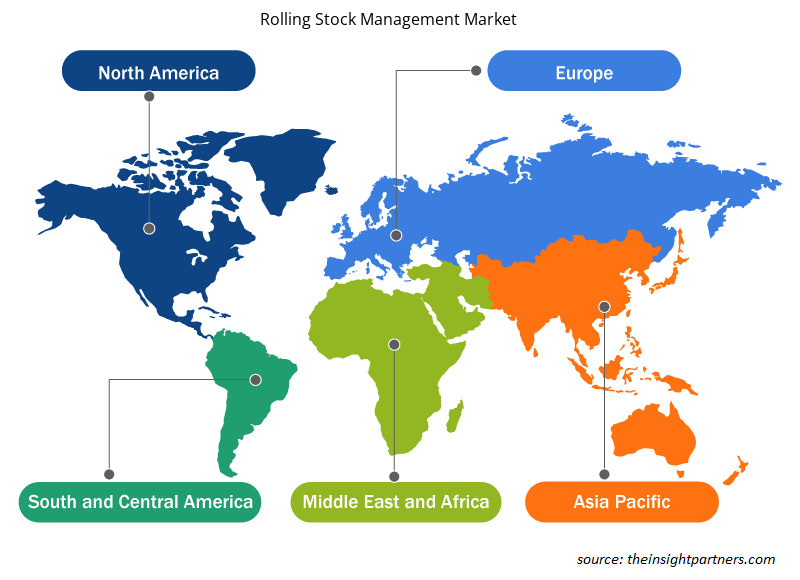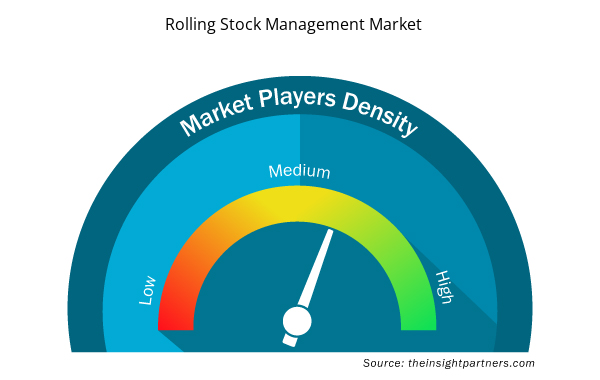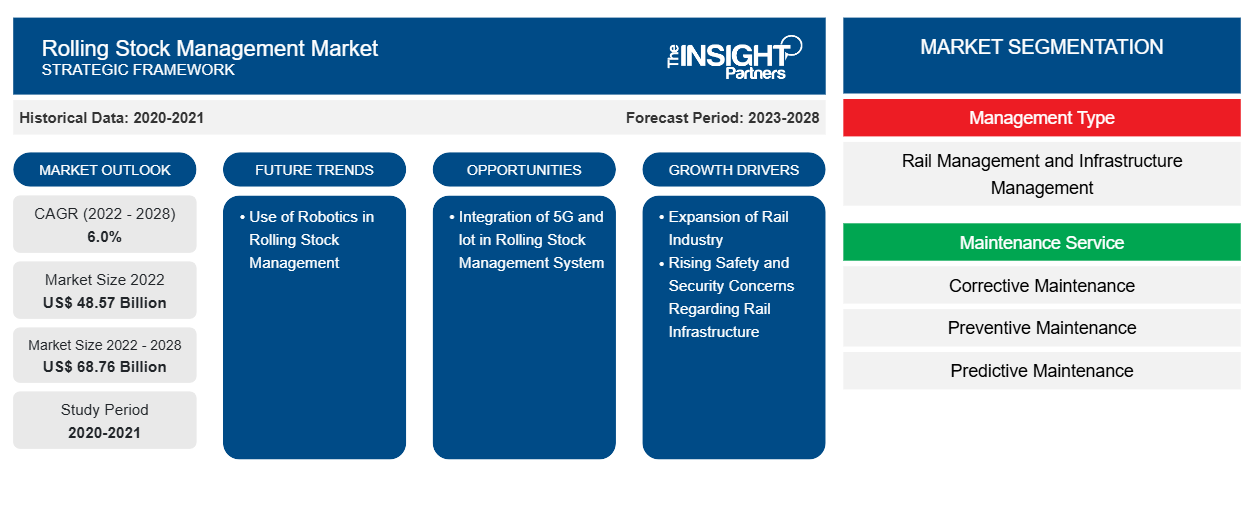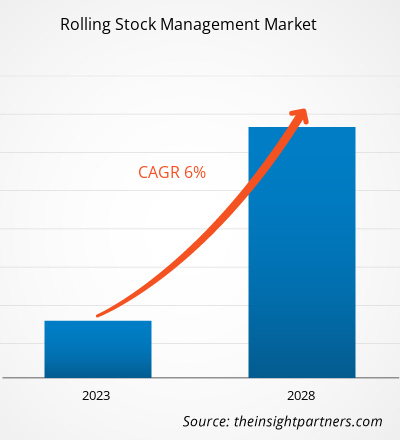[Informe de investigación] El mercado de gestión de material rodante se valoró en US$ 48.571,46 millones en 2022 y se espera que alcance los US$ 68.761,96 millones en 2028; se estima que registrará una CAGR del 6,0% de 2022 a 2028.
Perspectiva del analista:
El material rodante se refiere a los vehículos ferroviarios que incluyen tanto vehículos motorizados como no motorizados. Se refiere a cualquier vehículo ferroviario que pueda moverse sobre las vías del tren. El mantenimiento, el seguimiento de la información y la gestión del material rodante son las características clave del sistema de gestión del material rodante. Mantiene la información sobre el funcionamiento, así como los registros de averías e inspección del material rodante . También almacena los registros del material rodante desde su fabricación hasta la información sobre sus principales accesorios. La gestión del registro histórico del material rodante ayuda a los trabajadores, durante su inspección y avería, a gestionar eficazmente su trabajo. Además, este sistema ayuda a conectar colectivamente esta información a los sistemas de gestión del tráfico, los sistemas de materiales y contabilidad, los planes de transporte, etc. Por lo tanto, el sistema de gestión del material rodante es necesario para determinar el rendimiento óptimo del material rodante y de la industria ferroviaria.
Descripción general del mercado: mercado de gestión de material rodante
El auge de la industria ferroviaria es uno de los principales factores que contribuyen al mercado de gestión de material rodante . El creciente número de inauguraciones de nuevas estaciones ferroviarias y la expansión de la red ferroviaria generan la necesidad de un sistema de gestión de material rodante eficiente para gestionar el material rodante, su ruta y su mantenimiento.
A continuación se mencionan algunas de las principales estaciones y proyectos de ampliación ferroviaria:
- En marzo de 2022, Saudi Arabia Railways (SAR) inauguró la estación de trenes de pasajeros Al-Qurayyat en el marco del plan de la SAR de lanzar los trenes de pasajeros en dirección norte.
- En marzo de 2023, la Autoridad de Ferrocarriles Centrales de la India (CR) anunció su plan de construir seis nuevas estaciones de trenes suburbanos para atender a los trenes locales de Mumbai. CR Mumbai tiene 80 estaciones y, con la incorporación de estas seis estaciones, el valor llegará a 86.
Personalice este informe según sus necesidades
Obtendrá personalización en cualquier informe, sin cargo, incluidas partes de este informe o análisis a nivel de país, paquete de datos de Excel, así como también grandes ofertas y descuentos para empresas emergentes y universidades.
- Obtenga las principales tendencias clave del mercado de este informe.Esta muestra GRATUITA incluirá análisis de datos, desde tendencias del mercado hasta estimaciones y pronósticos.
Factor impulsor del mercado: mercado de gestión de material rodante
Expansión de la industria ferroviaria
La demanda de mejores servicios de transporte está creciendo rápidamente en todo el mundo. Según la Agencia Internacional de la Energía (AIE), en comparación con 2019, se espera que las actividades de pasajeros y mercancías se dupliquen para 2050. Según el Grupo del Banco Mundial, los ferrocarriles se consideran una de las formas más eficientes de transportar pasajeros y mercancías. Debido al aumento de las actividades de transporte, el Grupo del Banco Mundial está invirtiendo en el desarrollo de la industria ferroviaria para hacerla más eficiente. Muchas organizaciones están extendiendo su apoyo a los gobiernos de varios países en desarrollo para reformar la infraestructura ferroviaria e incorporar los ferrocarriles a la red de transporte de un país. Además, los gobiernos de los países en desarrollo están invirtiendo para impulsar su industria ferroviaria. Según la India Brand Equity Foundation, para 2030, el país invertirá ~US$ 715,41 mil millones en infraestructura y desarrollo ferroviario. Para gestionar el aumento del tráfico de pasajeros y mercancías, los países están ampliando su infraestructura ferroviaria. Por ejemplo, en septiembre de 2022, el Departamento de Transporte de Connecticut (CTDOT) inauguró una nueva estación de tren en el condado de Hartford, EE. UU. Además, en enero de 2022, el Ministro de Inversiones de Arabia Saudita anunció el objetivo del país de ampliar la red ferroviaria en 8.000 km. El sistema de gestión del material rodante ayuda a mejorar el rendimiento óptimo del material rodante. El aumento de la expansión y el desarrollo de la industria ferroviaria está creando una demanda de material rodante como locomotoras , vagones de mercancías y trenes de pasajeros, lo que impulsa aún más la demanda de un sistema de gestión eficiente del material rodante.
Análisis segmentario: mercado de gestión de material rodante
Según el tipo de gestión, el mercado de gestión de material rodante se divide en gestión ferroviaria e infraestructura. Según el servicio de mantenimiento, el mercado de gestión de material rodante se clasifica en mantenimiento correctivo, mantenimiento preventivo y mantenimiento predictivo. Geográficamente, el mercado de gestión de material rodante se segmenta en América del Norte, Europa, Asia Pacífico, Oriente Medio y África, y América del Sur.
Análisis regional: mercado de gestión de material rodante
El mercado de gestión de material rodante se clasifica en cinco regiones principales: América del Norte, Europa, Asia Pacífico (APAC), Oriente Medio y África (MEA) y América del Sur (SAM). El crecimiento del mercado mundial de gestión de material rodante aéreo se atribuye al aumento del tráfico de pasajeros y al aumento de las estaciones ferroviarias. La mayoría de las redes ferroviarias convencionales se encuentran en América del Norte, Europa y APAC. Según los datos de la Administración Federal de Tránsito en 2019, estas regiones representan aproximadamente el 90% de los movimientos mundiales de pasajeros en un ferrocarril convencional, con India a la cabeza con el 39%, seguida de China con el 27%, Japón con el 11% y la Unión Europea con el 9%. El creciente número de infraestructuras y pasajeros está impulsando la necesidad de adquirir este material rodante para satisfacer la demanda de mayores servicios de mantenimiento. Por lo tanto, el aumento del número de estaciones ferroviarias está impulsando la demanda de servicios de gestión de material rodante para la eficiencia, la confiabilidad y la seguridad entre los ferrocarriles y las estaciones, lo que impulsa el mercado de gestión de material rodante.
Análisis de los actores clave: mercado de gestión de material rodante
Algunos de los principales actores que operan en el mercado de gestión de material rodante son Alstom SA, Hitachi Rail Ltd, ABB Ltd, Mitsubishi Electric Corp, Siemens Mobility GmbH, Talgo SA, Thales SA, Toshiba Infrastructure Systems and Solutions Corp, Trimble Inc y LocoTech LLC. Muchas empresas están invirtiendo en la gestión de material rodante debido a las posibles mejoras relacionadas con la precisión, la eficiencia operativa y el cumplimiento puntual de los pedidos de material rodante.
Perspectivas regionales del mercado de gestión de material rodante
Los analistas de Insight Partners explicaron en detalle las tendencias y los factores regionales que influyen en el mercado de gestión de material rodante durante el período de pronóstico. Esta sección también analiza los segmentos y la geografía del mercado de gestión de material rodante en América del Norte, Europa, Asia Pacífico, Oriente Medio y África, y América del Sur y Central.

- Obtenga los datos regionales específicos para el mercado de gestión de material rodante
Alcance del informe de mercado sobre gestión de material rodante
| Atributo del informe | Detalles |
|---|---|
| Tamaño del mercado en 2022 | US$ 48,57 mil millones |
| Tamaño del mercado en 2028 | US$ 68,76 mil millones |
| CAGR global (2022-2028) | 6.0% |
| Datos históricos | 2020-2021 |
| Período de pronóstico | 2023-2028 |
| Segmentos cubiertos | Por tipo de gestión
|
| Regiones y países cubiertos | América del norte
|
| Líderes del mercado y perfiles de empresas clave |
|
Densidad de actores del mercado: comprensión de su impacto en la dinámica empresarial
El mercado de gestión de material rodante está creciendo rápidamente, impulsado por la creciente demanda de los usuarios finales debido a factores como la evolución de las preferencias de los consumidores, los avances tecnológicos y una mayor conciencia de los beneficios del producto. A medida que aumenta la demanda, las empresas amplían sus ofertas, innovan para satisfacer las necesidades de los consumidores y aprovechan las tendencias emergentes, lo que impulsa aún más el crecimiento del mercado.
La densidad de actores del mercado se refiere a la distribución de las empresas o firmas que operan dentro de un mercado o industria en particular. Indica cuántos competidores (actores del mercado) están presentes en un espacio de mercado determinado en relación con su tamaño o valor total de mercado.
Las principales empresas que operan en el mercado de gestión de material rodante son:
- Alstom SA
- ABB Ltd
- Hitachi Rail Ltd
- Corporación Mitsubishi Electric
- Siemens Mobility GmbH
Descargo de responsabilidad : Las empresas enumeradas anteriormente no están clasificadas en ningún orden particular.

- Obtenga una descripción general de los principales actores clave del mercado de gestión de material rodante
Desarrollos recientes: Mercado de gestión de material rodante
Las estrategias inorgánicas y orgánicas, como las fusiones y adquisiciones, son ampliamente adoptadas por las empresas del mercado de gestión de material rodante. A continuación, se enumeran algunos de los principales desarrollos recientes en este mercado:
- En 2023, Alstom firmó un contrato con la Autoridad Portuaria de Nueva York y Nueva Jersey y el Aeropuerto Internacional Newark Liberty para brindar servicios de operación y mantenimiento para su sistema de monorraíl Innovia, AirTrain Newark, durante los próximos siete años hasta enero de 2030. El contrato está valorado en más de US$ 260 millones e incluye una opción por un año adicional.
- En 2023, ABB recibió pedidos por 170 millones de dólares de Stadler, una multinacional suizo-sueca, para impulsar más de 300 trenes y locomotoras nuevos. Los trenes se utilizaron en varias redes ferroviarias europeas para modernizar y reforzar el transporte ferroviario en países como el Reino Unido, España, Portugal, Alemania y Austria, así como en algunos corredores ferroviarios europeos.
- En 2023, Siemens Mobility entregó 1200 locomotoras eléctricas y prometió 35 años de mantenimiento completo. Se considera el pedido de locomotoras más grande en la historia de Siemens Mobility y Siemens India. Con esto, Siemens Mobility ha fortalecido su posición en el mercado.
- En 2022, Thales demostró a las partes interesadas una nueva tecnología ferroviaria que hizo que la red ferroviaria del Reino Unido fuera más segura para los trabajadores de las vías, las tripulaciones de los trenes y los pasajeros. Thales trabajó con Network Rail y West Somerset Railway (WSR) para realizar una demostración en vivo de su sistema de protección y advertencia de trenes con supervisión continua (TPWS-CS).
- Análisis histórico (2 años), año base, pronóstico (7 años) con CAGR
- Análisis PEST y FODA
- Tamaño del mercado Valor/volumen: global, regional, nacional
- Industria y panorama competitivo
- Conjunto de datos de Excel


- Maritime Analytics Market
- Hydrolyzed Collagen Market
- Vertical Farming Crops Market
- Educational Furniture Market
- GNSS Chip Market
- Electronic Data Interchange Market
- Neurovascular Devices Market
- Single-Use Negative Pressure Wound Therapy Devices Market
- Visualization and 3D Rendering Software Market
- Explosion-Proof Equipment Market

Report Coverage
Revenue forecast, Company Analysis, Industry landscape, Growth factors, and Trends

Segment Covered
This text is related
to segments covered.

Regional Scope
North America, Europe, Asia Pacific, Middle East & Africa, South & Central America

Country Scope
This text is related
to country scope.
Preguntas frecuentes
APAC is anticipated to grow with the highest CAGR over the forecast period.
The rolling stock management market was estimated to be US$ 48,571.46 million in 2022 and is expected to grow at a CAGR of 6.0 %, during the period 2022 - 2028.
The military drone market is expected to reach US$ 68,761.96 million by 2028
The key players, holding majority shares, in rolling stock management market includes Alstom SA, Siemens Mobility GmbH, Mitsubishi Electric Corp, Hitachi Rail Ltd, and Toshiba Infrastructure Systems and Solutions Corp.
The use of 5G in the rolling stock management provides higher bandwidth for the data transmission between the rolling stock and authorities engaged in its management. It also improves train-to-ground communications and helps the operators make better decisions regarding the action needed to maintain the reliable operation of the rolling stock.
1. Expansion of Rail Industry
2. Rising Safety and Security Concerns Regarding Rail Infrastructure
Trends and growth analysis reports related to Automotive and Transportation : READ MORE..
The List of Companies - Rolling Stock Management Market
- Alstom SA
- ABB Ltd
- Hitachi Rail Ltd
- Mitsubishi Electric Corp
- Siemens Mobility GmbH
- Talgo SA
- Thales SA
- Toshiba Infrastructure Systems and Solutions Corp
- Trimble Inc
- LocoTech LLC
The Insight Partners performs research in 4 major stages: Data Collection & Secondary Research, Primary Research, Data Analysis and Data Triangulation & Final Review.
- Data Collection and Secondary Research:
As a market research and consulting firm operating from a decade, we have published and advised several client across the globe. First step for any study will start with an assessment of currently available data and insights from existing reports. Further, historical and current market information is collected from Investor Presentations, Annual Reports, SEC Filings, etc., and other information related to company’s performance and market positioning are gathered from Paid Databases (Factiva, Hoovers, and Reuters) and various other publications available in public domain.
Several associations trade associates, technical forums, institutes, societies and organization are accessed to gain technical as well as market related insights through their publications such as research papers, blogs and press releases related to the studies are referred to get cues about the market. Further, white papers, journals, magazines, and other news articles published in last 3 years are scrutinized and analyzed to understand the current market trends.
- Primary Research:
The primarily interview analysis comprise of data obtained from industry participants interview and answers to survey questions gathered by in-house primary team.
For primary research, interviews are conducted with industry experts/CEOs/Marketing Managers/VPs/Subject Matter Experts from both demand and supply side to get a 360-degree view of the market. The primary team conducts several interviews based on the complexity of the markets to understand the various market trends and dynamics which makes research more credible and precise.
A typical research interview fulfils the following functions:
- Provides first-hand information on the market size, market trends, growth trends, competitive landscape, and outlook
- Validates and strengthens in-house secondary research findings
- Develops the analysis team’s expertise and market understanding
Primary research involves email interactions and telephone interviews for each market, category, segment, and sub-segment across geographies. The participants who typically take part in such a process include, but are not limited to:
- Industry participants: VPs, business development managers, market intelligence managers and national sales managers
- Outside experts: Valuation experts, research analysts and key opinion leaders specializing in the electronics and semiconductor industry.
Below is the breakup of our primary respondents by company, designation, and region:

Once we receive the confirmation from primary research sources or primary respondents, we finalize the base year market estimation and forecast the data as per the macroeconomic and microeconomic factors assessed during data collection.
- Data Analysis:
Once data is validated through both secondary as well as primary respondents, we finalize the market estimations by hypothesis formulation and factor analysis at regional and country level.
- Macro-Economic Factor Analysis:
We analyse macroeconomic indicators such the gross domestic product (GDP), increase in the demand for goods and services across industries, technological advancement, regional economic growth, governmental policies, the influence of COVID-19, PEST analysis, and other aspects. This analysis aids in setting benchmarks for various nations/regions and approximating market splits. Additionally, the general trend of the aforementioned components aid in determining the market's development possibilities.
- Country Level Data:
Various factors that are especially aligned to the country are taken into account to determine the market size for a certain area and country, including the presence of vendors, such as headquarters and offices, the country's GDP, demand patterns, and industry growth. To comprehend the market dynamics for the nation, a number of growth variables, inhibitors, application areas, and current market trends are researched. The aforementioned elements aid in determining the country's overall market's growth potential.
- Company Profile:
The “Table of Contents” is formulated by listing and analyzing more than 25 - 30 companies operating in the market ecosystem across geographies. However, we profile only 10 companies as a standard practice in our syndicate reports. These 10 companies comprise leading, emerging, and regional players. Nonetheless, our analysis is not restricted to the 10 listed companies, we also analyze other companies present in the market to develop a holistic view and understand the prevailing trends. The “Company Profiles” section in the report covers key facts, business description, products & services, financial information, SWOT analysis, and key developments. The financial information presented is extracted from the annual reports and official documents of the publicly listed companies. Upon collecting the information for the sections of respective companies, we verify them via various primary sources and then compile the data in respective company profiles. The company level information helps us in deriving the base number as well as in forecasting the market size.
- Developing Base Number:
Aggregation of sales statistics (2020-2022) and macro-economic factor, and other secondary and primary research insights are utilized to arrive at base number and related market shares for 2022. The data gaps are identified in this step and relevant market data is analyzed, collected from paid primary interviews or databases. On finalizing the base year market size, forecasts are developed on the basis of macro-economic, industry and market growth factors and company level analysis.
- Data Triangulation and Final Review:
The market findings and base year market size calculations are validated from supply as well as demand side. Demand side validations are based on macro-economic factor analysis and benchmarks for respective regions and countries. In case of supply side validations, revenues of major companies are estimated (in case not available) based on industry benchmark, approximate number of employees, product portfolio, and primary interviews revenues are gathered. Further revenue from target product/service segment is assessed to avoid overshooting of market statistics. In case of heavy deviations between supply and demand side values, all thes steps are repeated to achieve synchronization.
We follow an iterative model, wherein we share our research findings with Subject Matter Experts (SME’s) and Key Opinion Leaders (KOLs) until consensus view of the market is not formulated – this model negates any drastic deviation in the opinions of experts. Only validated and universally acceptable research findings are quoted in our reports.
We have important check points that we use to validate our research findings – which we call – data triangulation, where we validate the information, we generate from secondary sources with primary interviews and then we re-validate with our internal data bases and Subject matter experts. This comprehensive model enables us to deliver high quality, reliable data in shortest possible time.


 Obtenga una muestra gratuita de este informe
Obtenga una muestra gratuita de este informe